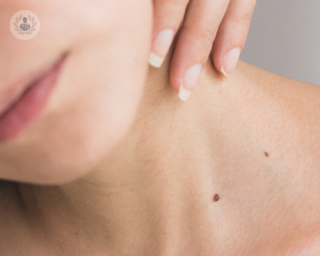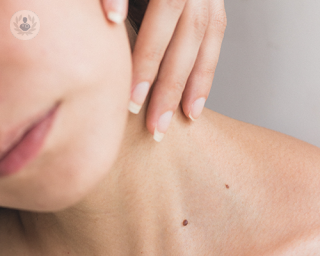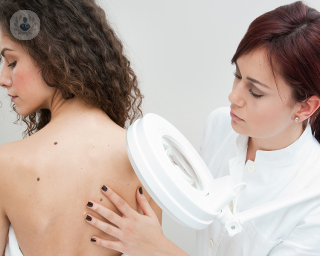Skin tag removal
Dr Marisa Taylor - Dermatology
Created on: 09-22-2020
Updated on: 07-13-2023
Edited by: Carlota Pano
What are skin tags, and how harmful are they?
Skin tags are small benign growths that can hang from your skin. They are relatively common and are not harmful. However, some people with skin tags prefer to have them removed if they do not like their appearance, or if they are located in a place that causes irritation (e.g. near bra straps, or on the neck close to jewellery).
How are skin tags typically removed?
Skin tag removal involves either freezing or burning them off, or removing them surgically.

What do skin tags consist of?
Skin tags are generally made up of a mixture of fat, collagen fibers, tiny blood vessels, and nerve cells.
What causes the appearance of skin tags?
If you begin to develop an abnormally high number of skin tags, this may be due to a hormonal imbalance or an early sign of pre-diabetes or frank diabetes.
Where on the body are skin tags most commonly found?
Skin tags most typically appear on the neck, the armpits, around the eyes, and beneath the breasts.
Who is most at risk from getting skin tags?
Although not proven, various studies have demonstrated that people who suffer from diabetes, who are overweight, and/or who are pregnant, are at a higher risk of getting skin tags on some area(s) of their skin.
What are the most common/most popular skin tag removal options, and how are they performed?
As mentioned above, skin tags are not harmful, and thus, need not be removed. However, if one's skin becomes irritated, there are various different options available for patients who wish to have them removed.
One such option is cryotherapy. Cryotherapy consists of a dermatologist freezing off the skin tag via the use of liquid nitrogen, which is a highly effective way of removing skin tags.
Other skin tag removal options include shave excision, snipping, and electrocautery. where an electric probe or needle is used to burn off the skin tag.
What does skin tag removal surgery consist of?
Skin tag removal surgery is an outpatient procedure. If surgical excision is required, your dermatologist will numb the area of skin where the skin tag is located with a local anaesthetic. Once the area is numb, your dermatologist will then carefully remove the skin tag.
Which specialist treats skin tags?
Typically, dermatologists are the medical specialists who are responsible for treating skin tags and performing skin tag removal surgery.

Is it safe to remove my skin tag at home?
It is recommended that patients avoid trying to remove their skin tags themselves at home to avoid infection, and for larger skin tags, excessive bleeding and scarring. A dermatologist is highly skilled when it comes to removing skin tags for patients.
Are skin tags an early warning sign of skin cancer?
Thankfully, the development of skin tags are not deemed to be an early warning sign of skin cancer. However, there are skin cancers that can look like a skin tag and if you are not sure, it is best to visit your dermatologist for a skin biopsy.
Are they contagious?
No, skin tags cannot be passed from one individual to another.
How big can skin tags become?
It is thought that skin tags can grow up to five centimetres in diameter.
How will I know if they are skin tags?
The appearance of a skin tag will typically be brown or flesh colour. They are bump-like pieces of irritated skin, and they can either be smooth or wrinkled in texture.















